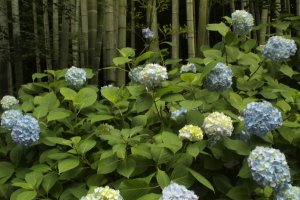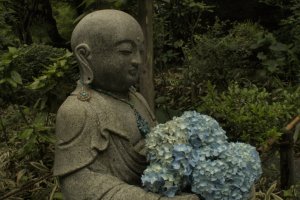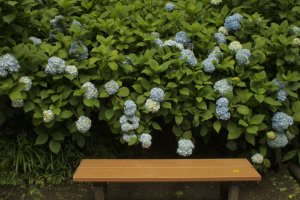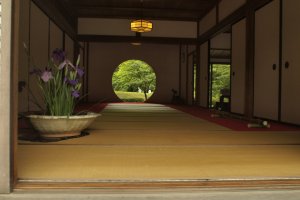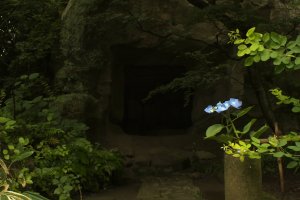The first rain in April stirred the growth of the solitary hydrangea (Ajisai 紫陽花) shrub in my little garden. It stimulated its hibernating leaves and awakened its tiny buds. In May, they started to blossom. It’s June, they are now in full bloom. At first, the blossoms were white; eventually, they turned light blue. Every morning, they greet me.
Hydrangeas love water. In the rain, this native to China rejoices and displays its most relaxing colors. In the sun, they wilt and look sad.
I got the idea of planting a hydrangea shrub after a visit to Meigetsuin Temple (of the Rinzai Zen school of Buddhism founded in 1383) in Kamakura a few years ago. Meigetsuin Temple, also called the ‘Hydrangea Temple’, hosts one of the most glorious ‘gatherings of blues’ in the summer in the country.
Through a friend, I learned about this garden. I was advised not to visit the temple on the weekends. The queue at the entrance, I was warned, would be long and frustrating. Thus, one Wednesday, I decided to treat myself and have a day off amongst the blues in Kamakura.
Hydrangea signal the arrival of the rainy season. When they wither, summer commences.
It had been raining when I arrived at Kita-Kamakura Station in the afternoon. The ten-minute walk to Meigetsuin Temple was hushed in the mist. It was still drizzling.
There were no long lines at the entrance but the park was teeming with visitors; everyone was armed with a camera. Young and old, high school students and elderly people -- no one could resist the charms of the blossoms.
Amongst the ‘gathering blues,’ one feels lost. The garden suffused with soft blue scenery, I couldn’t help but marvel at this tiny oasis, far from the concrete jungles of Yokohama and Tokyo.
As I walked around, I noticed the bamboo trees along the edges. Tall, luxuriant, leafy – what a quiet harmony it provides with the thousands of globular blues. I thought: elegant trees restraining the invigorating blossoms.
And if you look closely at the caves dug into the rocks surrounding the garden, you would discover a quiet if not forlorn graveyard – a final resting place for elite Buddhist priests and samurai. The phantoms of holy men and great warriors watch over the unwary visitors.
Meigetsuin's hydrangeas, planted after the end of World War II, are called ‘Hime Ajisai’ – Princess Hydrangea. Their pale blue flowers are in sharp contrast with the large and vivid ones at the nearby Hasedera Temple.
In the tatami matted main hall (hojo) of Meigetsuin in the back of the garden, there is one important sight that would surely captivate the visitor – it’s ‘satori no mado’ – the ‘window of enlightenment.’ No visitors, in their right mind, would not stop and marvel at this sight: a circular window; on the foreground stands a vase of irises; on the ride by the sliding paper doors, is a pair of green bamboos perched on rests. This is one of the essence of Japanese aesthetics – nothingness as the symbol of truth, universe, and also of the bright full moon (meigetsu). Outside the window is a garden of irises. In the autumn, it becomes a garden of bright colorful leaves.
After my visit to garden, I dropped by at the nearby garden centre in my neighbourhood. I bought a Princess Hydrangea. It now blooms in my garden.


